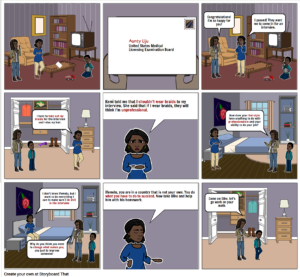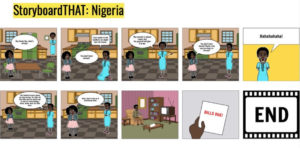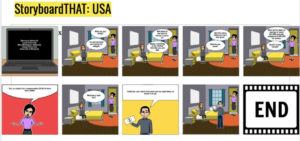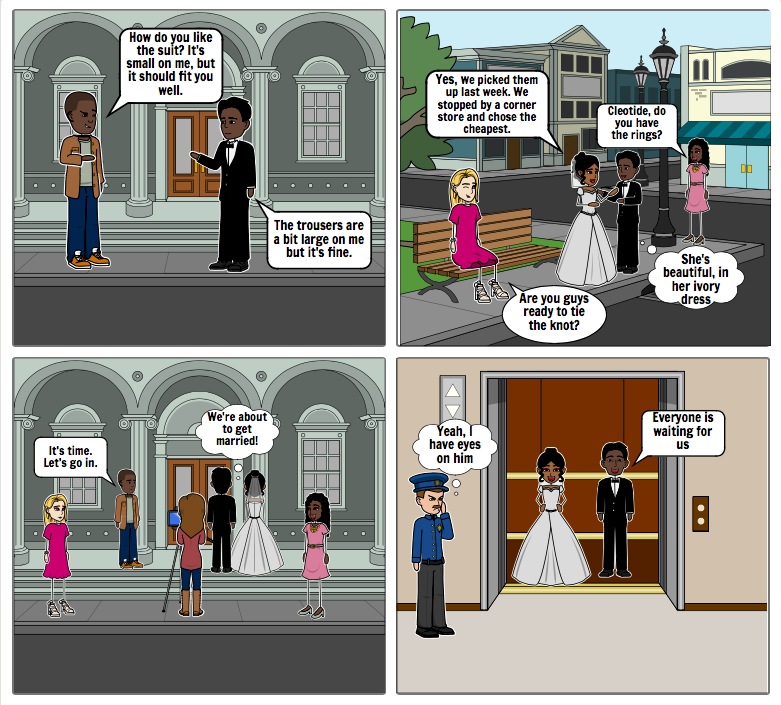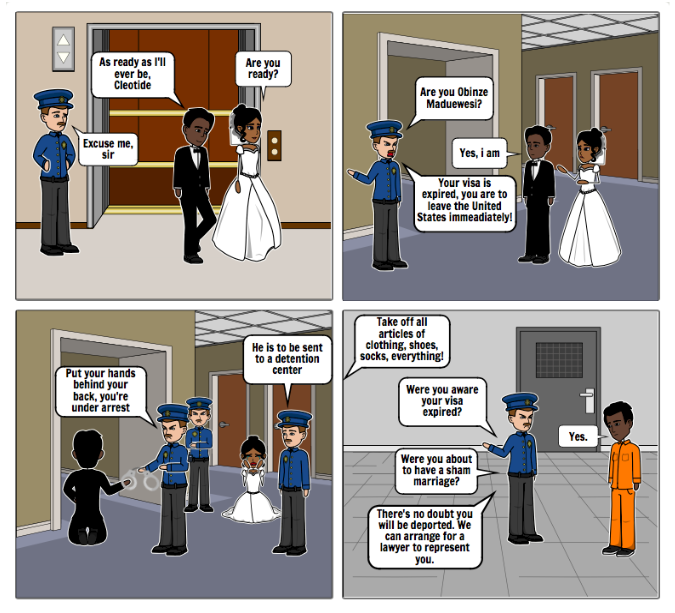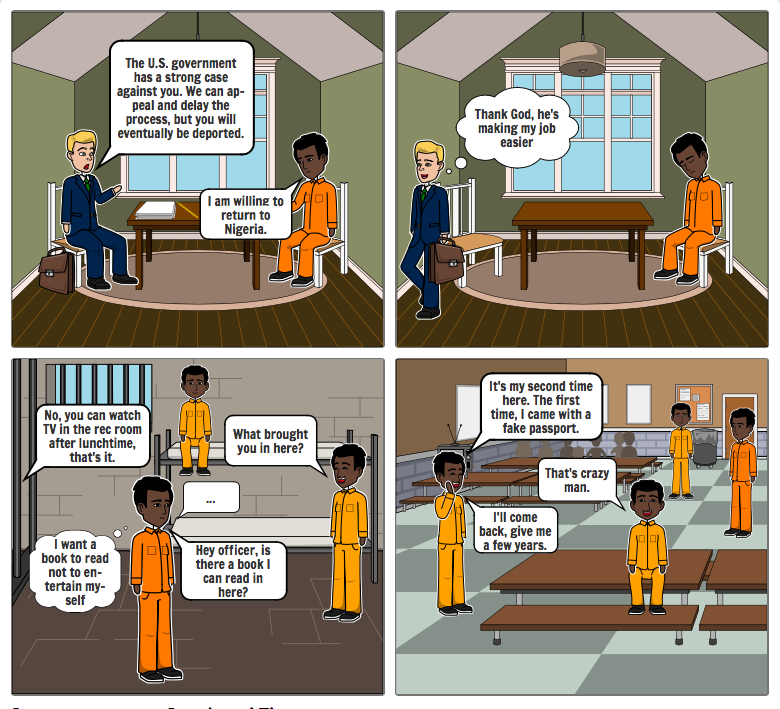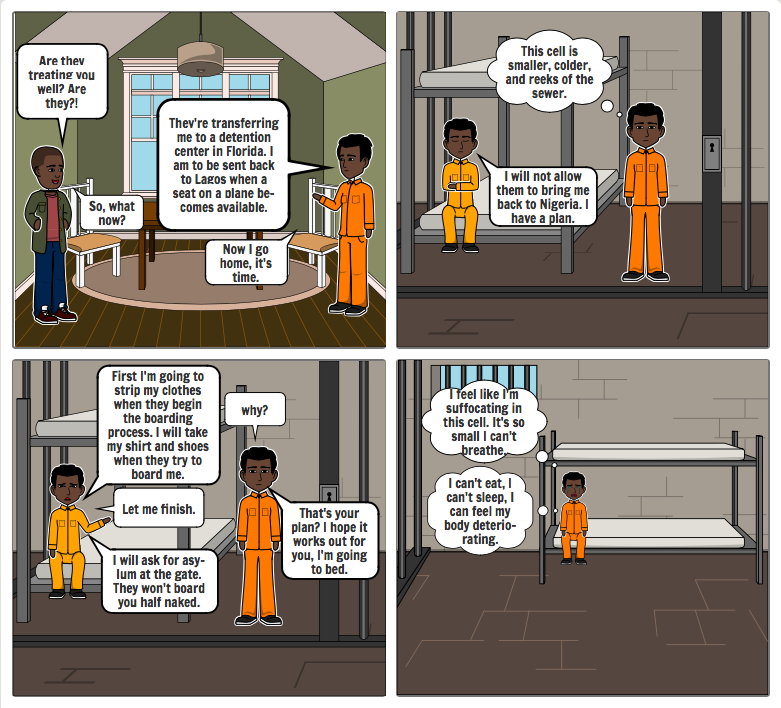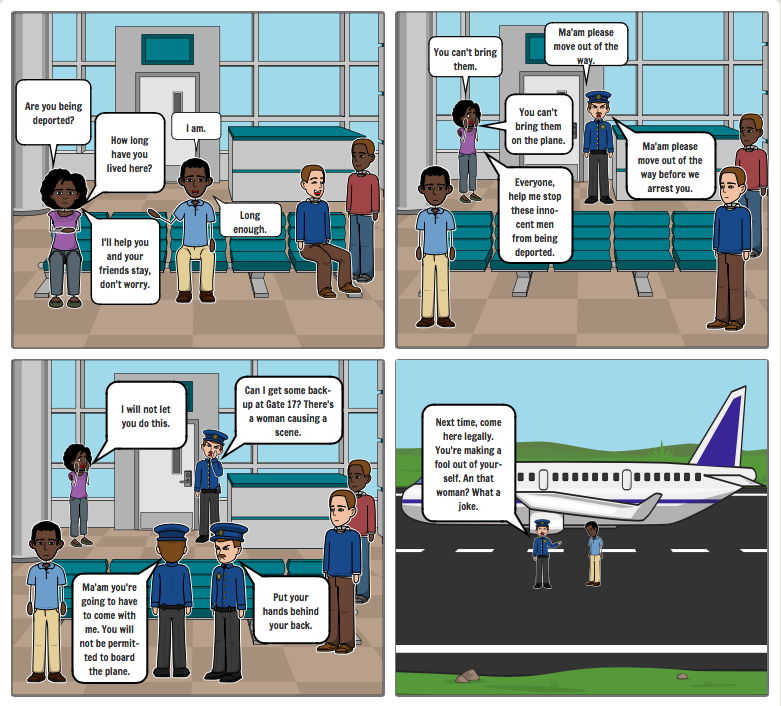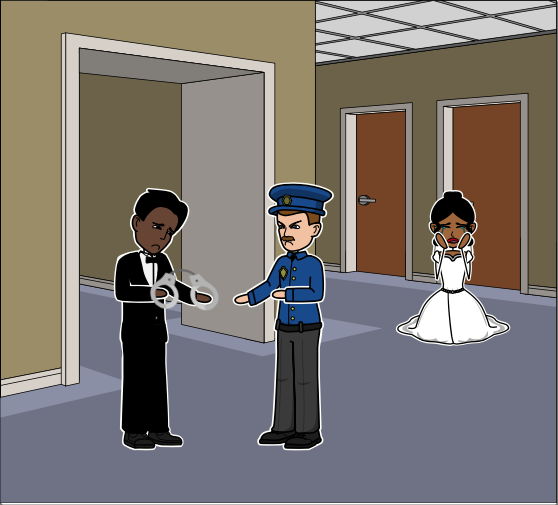Digital Publishing: Americanah
Chapter 11: Natural Hair, Immigration and Discrimination Within America: Final Project
Olivia Hare, Lauren Aversa, Adonte Langston, Samantha Hacker
PROPOSAL
We will adapt chapter 11 of Americanah by Chimamanda Ngozi Adichie into an interactive experience using Storyboard That. Throughout the novel, Adichie uses hair as a symbol of the oppression and culture that immigrants experience within America. Chapter 11 of the text illustrates Aunty Uju and Ifemelu’s experience with their natural hair while adapting to the professional standards and acceptable norms.
Aunty Uju begins to the feel need to adapt to acceptable norms many times throughout the novel. One particular instance occurs when she passes her United States Medical Licensing Examination to become a licensed family physician within America. After receiving this acceptance she is concerned about her hair, stating: “I have to take my braids out for my interviews and relax my hair. Kemi told me that I shouldn’t wear braids to the interview. If you have braids, they will think you are unprofessional” (Adichie, 146). Ifemelu is unhappy with this idea, but Auntie Uju insists that “you are in a country that is not your own. You do what you have to do if you want to succeed” (Adichie, 146).
Aunty Uju and Ifemelu’s experience with the pressure to alter their natural hair is a common phenomenon for immigrants beginning to adapt to the United States. An article published by Allure Magazine titled “Goodbye to ““‘”Good Hair”: How I Learned to Love My Natural Texture After Moving to America,“”” discusses author Elaine Musiwa’s experience as a first-generation immigrant from Zimbabwe. Musiwa accounts her hair being labeled as “nappy” and “kinky” when moving to America. Musiwa had a strong pressure to perm her hair or apply box braids. Similarly, in February 2019, new guidelines were released by the New York City Commission on Human Rights enforcing that targeting people based on their hair or hairstyle, at work, school or in public spaces, is now considered racial discrimination (Stowe, 2019).
The final project’s interactive story medium is a digital storyboard using “Storyboard That.” The storyboard will consist of multiple panels that will recreate Ifemelu and Aunty Uju’s discussion in Chapter 11 about Aunty Uju taking her braids out for her job interview because she was told that in America braids are seen as unprofessional and she wanted to present herself in a professional manner (Adichie 146). The digital storyboard helps visualize the interaction between Ifemelu and her aunt and present the overall message in a simple manner that is easy for viewers to understand.
BIBLIOGRAPHY
Bailey, Tamba-Kuii M., et al. “Development and Validation of the Internalized Racial Oppression Scale for Black Individuals.” Journal of Counseling Psychology, vol. 58, no. 4, Oct. 2011, pp. 481–493.
This article focuses on the development and validation of the Internalized Racial Oppression Scale. The article describes internalized racism and creates a scale in order to measure it. The focus is African Americans, and the current mindset that the dominant white culture has on these people. In order to keep a system of oppression in order, there needs to be some type of psychological rendering that makes the oppressed think this is self-perpetuating. In the United States there is no longer a need to directly oppress these populations because they will do it to themselves through their mindset. Internalized racism can be on of the most psychologically damaging form of racism. Internalized racism can manifest into a form of “self-hatred”. It allows people to begin thinking of themselves in a negative manor based off the ignorance of others. Existing negative stereotypes on African Americans helps create internalized racism. If African Americans are constantly shown negative depictions of themselves, they will begin to think they are negative people. This directly plays into the story of Americanah because the main character is constantly forced to either conform to western beauty standards or face criticism and discrimination. This article will be used to enforce the importance of understanding internalized racism and how damaging it can be. This article also relates to the character because she is directly facing internalized racism by being told her braids are unprofessional.
“Beauty Is Pain: Black Women’s Identity and Their Struggle with Embracing Their Natural Hair.” Perspectives (University of New Hampshire), Jan. 2017, pp. 1–13
This article examines the struggles that black women face constantly regarding their natural hair and identity. Most black women have naturally “curly” or “kinky” hair and depending on the society they are in, it affects the self-perception. Each culture has defined beauty standards and these women struggle to find their role in that standard. This article discusses the eurocentric beauty standard that affects African-American women and their view of their own beauty and self-identity. It analyzes how this affects black women’s image of themselves based on the societal pressure they face to change their hair . This article also discusses the political implications natural, black hair has in our society. African-American hair has been viewed negatively in society and this article aims to highlight that and how it affects women. It is shown that black women are oppressed and discriminated against constantly based on their appearance which ultimately affects their cultural identity. The article examines natural hair in the workplace and how black women are starting to challenge social norms. For the majority of black women, hair is not just hair. This article argues that women feel defined by their hair. What is considered “good” and what is “bad” is determined by the society not by the women wearing the hairstyle. As a result, women lose their sense of identity and don’t feel beautiful in the eyes of society. African American hairstyles are interpreted to represent social and economic class. Because of this, women feel that what their hair looks like either conforms to the white, Eurocentric society or goes against societal norms and embraces their natural culture. This article serves to inform and educate and audience about the history and importance of hair.
Stowe, Stacey. “New York City to Ban Discrimination Based on Hair.” The New York Times, The New York Times, 18 Feb. 2019.
Author Stacey Stowe is the author of an article for The New York Times titled, “New York City to Ban Discrimination Based on Hair.” Written in February of 2019, the article covers new guidelines placed in New York City to provide legal resources to those who have experienced discrimination based on hair. The guidelines focus on natural hair styles, most popular within black and African American communities. Specific hairstyles include locs, cornrows, twists, Bantu knots and afros. The New York Commission of Human Rights developed the guidelines that will consider discrimination based off of these hairstyles worthy of a penalty up to $25,000. This article benefits our research because it provides insight into how discrimination of natural hair has actually become a legal issue. The article is reliable because it provides statistics to support the information from resources such as an Army hair regulations video and population representation PDF. The article also provides interviews from professionals living within the New York City area who have experienced hair discrimination within the workplace. We are using the article as a resource to provide insight into personal experiences. We will use the interviews within the article to help build our script and plot for the storyboard. In addition, the article provides us with information on how this issue is presently being addressed.
Musiwa, Elaine. “How I Learned to Love My Natural Texture Despite America’s Beauty Standards.” Allure, Allure, 25 July 2018.
Elaine Musiwa is a first-generation immigrant to the United States from Zimbabwe. Within the article “How I Learned to Love My Natural Texture Despite America’s Beauty Standards” published by Allure Magazine, Musiwa discusses her experiences with her natural hair and how her opinions change when she comes to America. Musiwa discusses the idea of “good hair” and what that means within the United States. Musiwa illustrates her own personal challenges with straight vs. kinky hair and how her hair was a gift within her family, but not viewed the same within American standards. Musiwa talks about the idea of “social success” and giving up her hair to avoid taunting and bullying. When referring to her transition to America, Musiwa states “My hair became the first thing on my body that no longer belonged to me.” This article relates to our topic because it provides a first-hand look into the experience of an immigrant into America. Musiwa has to handle her transition into the United States, but also the discrimination that comes along with that. This source is reliable because it provides a unique account with quotes and different scenes from her life. Musiwa’s experience allows us to add a legitimacy to our piece by pulling inspiration from her experience. We will utilize the article to apply Musiwas feelings of what she needed to do in order to succeed within the United States. This article will be used to understand the thoughts, feelings and emotions of someone within this position.
Peed, Mike. “Realities of Race.” The New York Times, The New York Times, 7 June 2013, www.nytimes.com/2013/06/09/books/review/americanah-by-chimamanda-ngozi-adichie.html.
Mike Peed is a writer whose work has appeared in The New York Times, Washington Post, National Journal and more. His article, “Realities of Race” for The New York Times is a literary analysis for the book Americanah by Chimamanda Ngozi Adichie. The article reviews the text, more specifically, Adichie’s experience with race and culture in the United States. While the text covers many levels of the black immigrant experience, Peeds analysis of the treatment of women is most useful for this assignment. The article reviews Ifemelu’s experience with her hair, and comments received by white men within America such as “You ever wonder why he likes you looking all jungle like that?” As described within the text, the article uncovers the “discomforting realities” of the immigrant experience. This article will be used to take a closer look at the aspects of the immigrant experience as covered in this book. This source provides a unique analysis of the text from credible writer.
Rosenblatt, Kalhan. “louisiana girl sent home from school over braided hair extensions” NBCNEWS, NBCNEWS, 22 August 2018, https://www.nbcnews.com/news/nbcblk/louisiana-girl-sent-home-school-over-braided-hair-extensions-n902811
This article is a real life example of one of the topics expressed in Americanah. Written by Kalhan Rosenblatt, this article explains a situation where a young girl, named Faith, was forced to leave school because her hair did not match the schools regulations on hair. According to the administration at the school, all students are required to wear natural hair. The school enforced a policy where students are not allowed to wear hair extensions or weaves. This policy directly attacks African American females that usually wear extensions, weaves or braids in order to protect their natural hair and influence growth. Instead of coming up with an agreement and showing some type of understanding for the African American hairstyles, the school told the family that Faith could continue going there if she chooses to conform to the hair regulations. This is the reality for many African American women, they have to chose to conform to eurocentric standards or risk being discriminated against because of their hair. This source is useful to the project because it brings awareness to hair discrimination in America and the fact this is still happening today.
SCRIPT
Setting – A hot summer day in New York City at Aunty Uju’s apartment in Brooklyn which only has one single bed.
Characters –
Aunty Uju: Ifemelu’s aunt was a doctor in Nigeria before fleeing to America after a tragic loss and to give her son, Dike, a better life. Aunty Uju had an American Visa, and her son Dike has dual citizenship since he was born in America. She is Ifemelu’s closest relative and is always there for her. She works multiple jobs to pay for her life in NYC, but still continues to struggle tremendously. After moving to America, Aunty Uju’s personality is now cold and she seems very unhappy. She currently wears braids and is concerned about how her braids portray her. She has struggled in America with hardships and stress, but has hopes to become a doctor in America so she can continue to practice medicine.
Ifemelu: A young girl, Nigerian girl, who moved from Nigeria to America in hopes to continue her education and better her life. She left many of her family and friends behind in Nigeria, but still has her cousin and aunt to lean on while in America. Ifemelu is very close with her Aunty Uju and her younger cousin, Dike. She is currently living with her Aunty Uju and has to sleep on the floor. She expects America to be much different than it actually is, and is disappointed as to how much Aunty Uju has changed to adapt to life in America.
Dike: Aunty Uju’s six year old son who was born and raised in America. He lives with Ifemelu and his mother in a small apartment in Brooklyn. He attends an American school and is in the first grade. He is Ifemelu’s cousin and they are very close to each other. Ifemelu plays with him often and teaches him math since she is shocked that he cannot do simple division at his current age. He shares a bed with his mother, since they live in a small apartment and they do not have the money or space to purchase another bed. He does not know the difference between life in Nigeria or America, so Ifemelu does not get upset with him for acting “American.”
Plot – Aunty Uju’s results came from the United States Medical Licensing Examination. She receives the letter that informs her that she passed the examination to become a family physician within America. She states that she will have to take her braids out for her interview. Ifemelu is not happy that she feels she needs to change her natural appearance to make others happy.
Scene 1:
Ifemelu, Aunty Uju are talking in the small apartment living room while Dike sits on the floor playing. Aunty Uju walks over to pick up the mail off the table. She opens a letter from the United States Medical Licensing Examination Board. After scanning the letter, she looks up to Ifemelu with a smile on her face.
Aunty Uju: I passed! They want me to come in for an interview.
Ifemelu: Congratulations! I’m so happy for you!
Aunty Uju: Starts to walk into her bedroom and looks behind at Ifemelu with a look of panic. I have to find something to wear and take out my braids.
Ifemelu: Why do you need to take out your braids?
Aunty Uju: I have to take out my braids for the interview and relax my hair. Kemi told me that I shouldn’t wear braids to my interview. She said that if I wear braids, they will think I’m unprofessional.
Ifemelu: How does your hairstyle have anything to do with professionalism and your ability to do your job?
Aunty Uju: I don’t know Ifemelu, but I want to do everything I can to make sure I do well in the interview
Ifemelu: rolls her eyes. Why do you think you need to change what makes you, you just to impress someone?
Aunty Uju: Ifemelu, you are in a country that is not your own. You do what you have to do to succeed. Now take Dike and help him with his homework.
Ifemelu: Come on Dike, let’s go work on your math. Ifemelu grabs Dike’s hand and walks away angrily.
INTERACTIVE STORY
The final project’s interactive story medium is a digital storyboard using “Storyboard That.” The storyboard will consist of multiple panels that will recreate Ifemelu and Aunty Uju’s discussion in Chapter 11 about Aunty Uju taking her braids out for her job interview because she was told that in America braids are seen as unprofessional and she wanted to present herself in a professional manner (Adichie 146).
The digital storyboard helps visualize the interaction between Ifemelu and her aunt and present the overall message in a simple manner that is easy for viewers to understand.
REFERENCES
Bailey, Tamba-Kuii M., et al. “Development and Validation of the Internalized Racial Oppression Scale for Black Individuals.” Journal of Counseling Psychology, vol. 58, no. 4, Oct. 2011, pp. 481–493. EBSCOhost, search.ebscohost.com/login.aspx?direct=true&db=eric&AN=EJ945297&site=eds-live&scope=site
“Beauty Is Pain: Black Women’s Identity and Their Struggle with Embracing Their Natural Hair.” Perspectives (University of New Hampshire), Jan. 2017, pp. 1–13. EBSCOhost, search.ebscohost.com/login.aspx?direct=true&db=sih&AN=127094192&site=eds-live&scope=site
Musiwa, Elaine. “Goodbye to “Good Hair”: How I Learned to Love My Natural Texture After Moving to America.” Allure, Allure, 25 July 2018
Peed, Mike. “Realities of Race.” The New York Times, The New York Times, 7 June 2013, www.nytimes.com/2013/06/09/books/review/americanah-by-chimamanda-ngozi-adichie.html.
Rosenblatt, Kalhan. “louisiana girl sent home from school over braided hair extensions” NBCNEWS, NBCNEWS, 22 August 2018, https://www.nbcnews.com/news/nbcblk/louisiana-girl-sent-home-school-over-braided-hair-extensions-n902811
Stowe, Stacey. “New York City to Ban Discrimination Based on Hair.” The New York Times, The New York Times, 18 Feb. 2019.
